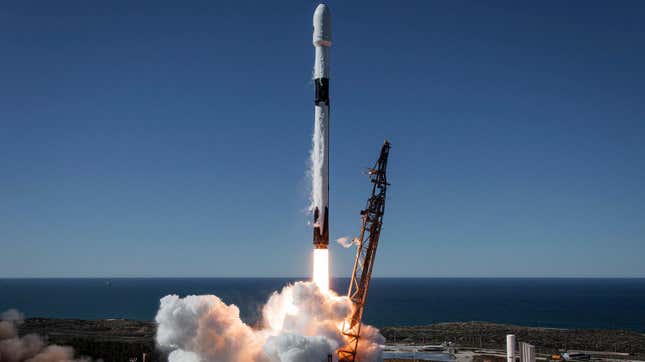
Russia just launched a mysterious satellite that could be spying on an even more mysterious U.S. military satellite, with the Russian spacecraft predicted to make a close approach to its presumed target this coming Thursday.
Before it launched on Monday, speculation already existed that the Russian satellite would be considered a so-called “inspector” satellite—one that stalks other satellites to sneak a closer look. The spy satellite, poised to receive the designation Kosmos 2558, launched into the same orbital plane as a U.S. military satellite, dubbed USA 326, that flew to space in February. Marco Langbroek, an astrodynamics lecturer at Delft Technical University in the Netherlands, tracked the orbital plane of the two satellites and found that the Russian satellite was launched at a time that coincided with the U.S. satellite passing over the Russian spaceport Plesetsk.
“The two orbits are very close, the main difference being a relatively small difference of a few tens of kilometers in orbital altitude,” Langbroek told Gizmodo in an email. “So that is a very clear indication.” The U.S. satellite is moving in a 97.4 degree inclined Sun-synchronous orbit, while the Russian satellite is moving in a 97.25 degree-inclined orbit, according to Langbroek. The Russian satellite might also maneuver its orbit within the next few days to move even closer to its U.S. counterpart.
“If one or both of them do not maneuver in the meantime, Kosmos 2558 will pass USA 326 at a distance of approximately 75 kilometers (46 miles) on August 4, near 14:47 UTC [10:47 a.m. ET],” Langbroek said.
This type of Russian satellite has already been used to stalk satellites in orbit. “Presumably, it has some kind of sensor system that’s optimized to observe other satellites, rather than the sort of usual observing satellite that’s optimized to take pictures of the ground,” Jonathan McDowell, an astronomer at the Harvard-Smithsonian Center for Astrophysics, told Gizmodo. “We don’t know that for sure, we’re just inferring that from how it’s behaving.” The satellite also has a maneuvering engine system, allowing it to adjust its orbit in various ways, he added. Both of these seem to be handy tools for stalking.
So, why did it pick USA 326 as its prey? Few details are known about the military satellite, which makes it all the more intriguing for Russia. “It’s a new model, and it’s of interest because we don’t know much about it,” McDowell said. “I want to know, and I’m sure the Russians have the exact same reaction.” By hovering next to it in space, the Russian satellite might be able to snap a few pictures of it to make note of any details, such as its antenna or a possible telescope.
Space stalking has happened before, with the U.S. sometimes being the culprit. In 2020, another Russian satellite, Kosmos 2542, stalked USA 245, an electro-optical spy satellite in low Earth orbit. In June 2017, classified U.S. military satellite USA 276 snuck up on the International Space Station at a close distance of about 4 miles (6.4 kilometers). Earlier in 1998, hobbyists discovered a U.S. satellite that was believed to have been used for space spying purposes as well.
In space, it’s not really illegal to stalk. “Even if the satellite stays 100 miles away from the U.S. satellite, the U.S. government will get all pissy about it and complain,” McDowell said. “But they don’t really have a right to complain because there’s no rule against it.” That is unless a satellite gets dangerously close to another satellite, he explained, with a potential risk of collision. “At what point are you in another satellite’s personal space? That’s the question,” McDowell added.
Langbroek will be tracking the two satellites in orbit over the next couple of days to see if they make a rather uncomfortable close approach. The U.S. satellite could potentially move out of its Russian counterpart’s way or it could just stay in place and put up with the unwanted attention. We’ll be watching.
More: Russian Motor Spontaneously Explodes in Orbit, Creating Debris Cloud